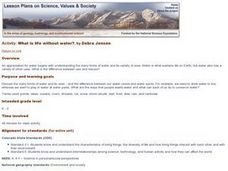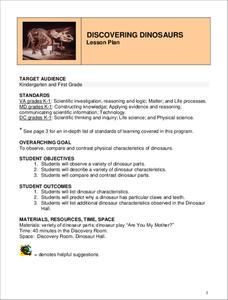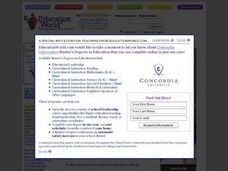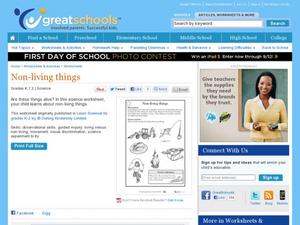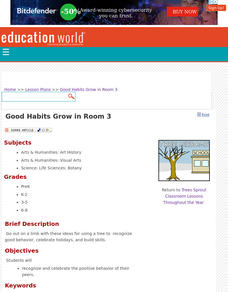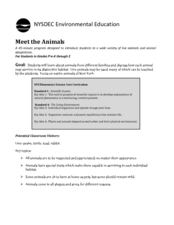Curated OER
Finding Captain Hook's Treasure
Students use their map-reading skills to find Captain Hook's treasure. They see how the directions on a map correspond with "real-life" directions, and that symbols on a map represent real things.
Curated OER
Earth & Space Science: Holding it Together
Pupils estimate how many drops of water can fit onto the surface of a penny and then test their hypothesis to find out. They also experiment with bubbles.
Curated OER
What is Life Without Water?
Pupils differentiate between how they use water in response to a need and how they use water for pleasure. They read books about water, participate in class discussion and illustrate their observations.
Curated OER
Observing Plants
Students identify how plants affect the survival of a caterpillar and what plants need to survive. They plant three bean seeds in the three containers, placing two containers at a sunny window and the third one in a dark closet and label...
Curated OER
Get to Know Your Body
Students explore the human body. In this science lesson plan, students name the basic body parts. Students play a game in which they balance using the designated number of body parts.
Curated OER
Pueblo of Laguna - Spring, New Life: Planting
Students name and describe three edible plants, plant corn kernels native to Laguna Pueblo (Indian Corn), care for their individual plants and compare and contrast ears of Indian corn to sweet corn.
Curated OER
Push or Pull?
Utilizing the Nebraska State Quarter, pupils learn about the pioneers who had wagons that were pulled across Nebraska by oxen during the westward movement. Excellent worksheets are embedded in the plan that guide them through this fine...
Curated OER
Discovering Dinosaurs
Students investigate the physical characteristics of dinosaurs. They participate in a puppet show, take a field trip to a dinosaur museum, and compare/contrast dinosaur characteristics at the museum.
Curated OER
Autumn Colors Shine Through
Pupils create colorful stained-glass Autumn window decorations. They shave crayons with scissors, melt the crayons in wax paper with an iron, and cut out a leaf pattern to display on windows.
Curated OER
The Changing Times of The Future
First graders share their wishes for the future and discuss changes that have taken place. They observe a puppet who describes life in the future and identifies positive and difficult challenges he may face. Individual students draw a...
Curated OER
Garbage Plants
Students create plants out of garbage. They identify items that can be recycled and discuss natural resources. They share their creation with the class.
Curated OER
Non-living Things
Very young scientists circle the things on the worksheet that they think are living things. Most of the pictures are of non-living things. A handy worksheet to use during any initial discussion about living vs. non-living things.
Curated OER
Good Habits Grow in Room 3
Students go out on a limb with these ideas for using a tree to recognize good behavior, celebrate holidays, and build skills. They recognize and celebrate the positive behavior of their peers.
Curated OER
Living vs. Nonliving
Students explore the characteristics that distinguish living things from nonliving things. Students examine video clips and still photographs to gather evidence and develop criteria to decide if something is living or nonliving.
Curated OER
Squanto's Science Lesson
Students explore Squanto's contribution to the settlers. They plant seeds and follow instructions for water and fertilization. Students keep a record of the growth of the seeds. They write a paragraph that tells what they learned from...
Curated OER
"I Have a Dream"
Students examine the role Martin Luther King Jr. played in America's history and what life was like in the 1960's. They watch and discuss an online video about the childhood of Martin Luther King, Jr. and the holiday enacted in his...
Curated OER
Children's Literature Across the Curriculum Ideas-The Very Hungry Caterpillar
Students read The Very Hungry Caterpillar by Eric Carle. They complete a variety of cross-curricular activities surrounding the study of caterpillars. Included are reading, art, math, science, writing, social studies, and library...
Curated OER
Different Environments
Students read literature selection, discuss habitat, divide habitats into different categories such as water, soil, and land, list animals that live in each habitat, and describe habitats using descriptive words in vocabulary list.
Curated OER
Leo's Colorful Story
Motivate your learners with this lesson plan about the Tiger Swallowtail Butterfly. They listen to a story about the butterfly and then follow directions to color pictures. This is a simple, but effective lesson plan with all the...
Curated OER
Tide Pool Discovery
First graders visit the Discovery Pool, where they use their senses to investigate the different tide pool species. They touch different species. Students describe how each one feels, and what they look like in words. They draw the...
Curated OER
Making Cents of the Senses
Students explore sight and hearing. In this senses lesson, students read Brown Bear Brown Bear, discuss how eyes are used for sight, and chart the eye color of the students in the class. Students discuss how hearing is important, take a...
Curated OER
Meet the Animals
The class will examine a series of live or stuffed animals in order to learn how different animals survive in distinctive habitats. As they examine each animal, they will be asked a series of critical thinking questions geared at getting...
Curated OER
Sea World
Students select a topic related to marine animals, research several book marked Internet sites, color pages, download data, and present their work to the class.
Curated OER
Spark Activity: Snakes and Lizards
Learners are divided into 2 groups: "snakes" and "lizards." Lizards move about the room in a way designated by the teacher, while snakes remain on their "rock" holding a given object and perform a balancing movement. Lizards guess what...
Other popular searches
- K 2 Life Science Growth
- K 2 Life Science Living
- K 2 Life Science Insects
- K 2 Life Science Salamander
- K 2 Life Science Hibernation
- K 2 Life Science Adaptation
- K 2 Life Science Cells
- K 2 Life Science Nonliving
- K 2 Life Science Wind


